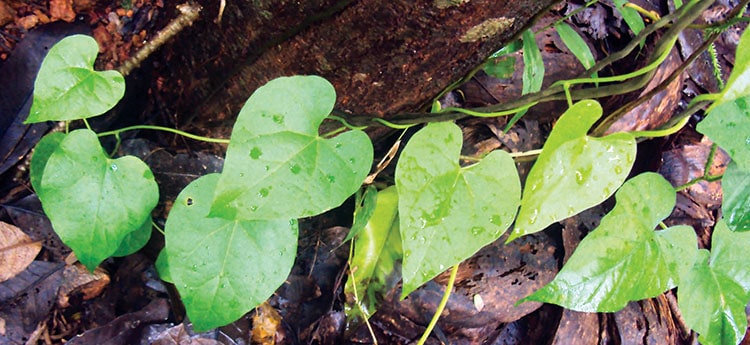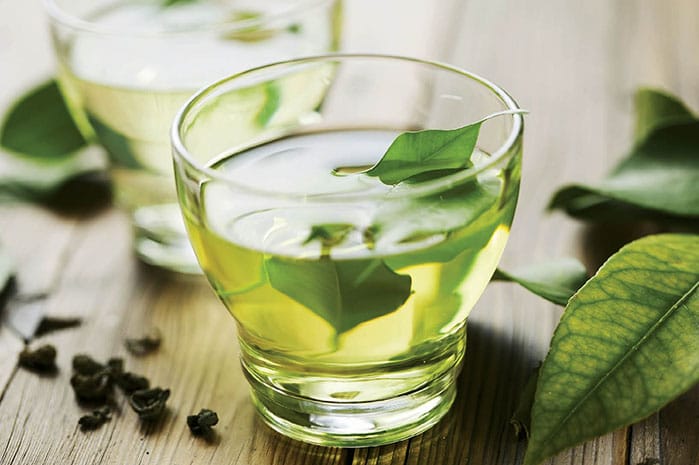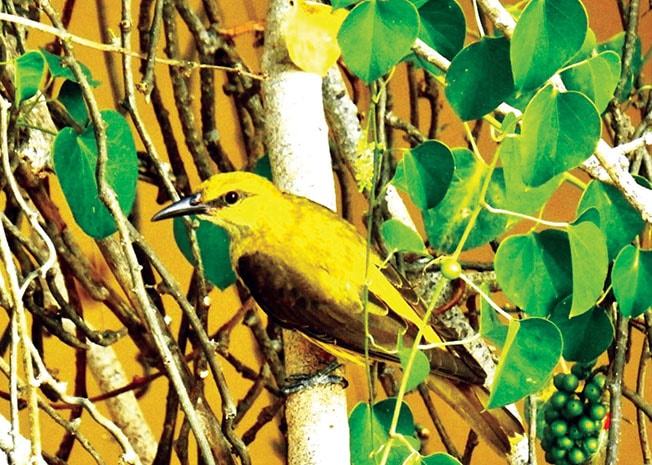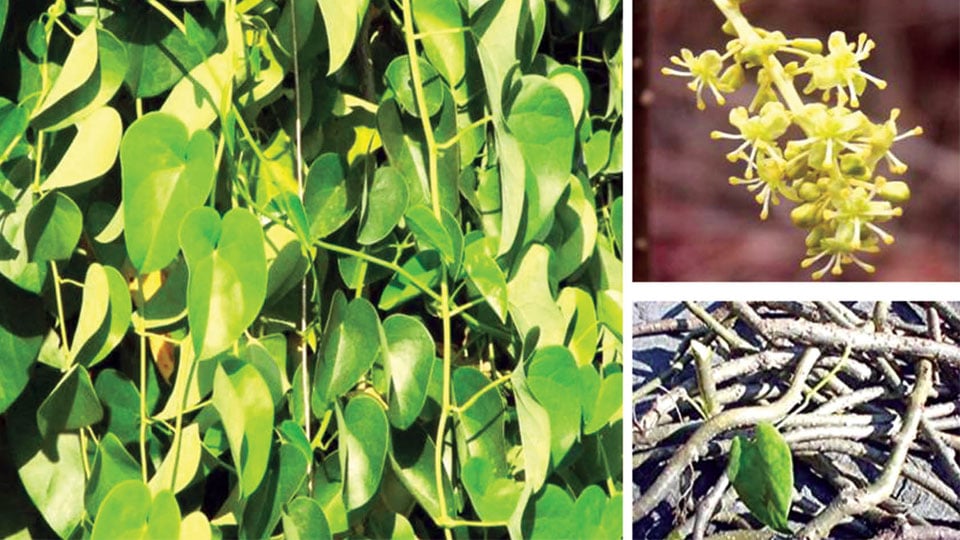By Dr. Mahadeswara Swamy, Scientist
In recent months, ayurvedic medicines and herbs are gaining more importance for their usefulness to boost immunity besides being used by many to defend themselves from Corona infection in the current crisis. It seems the people have reposed confidence in the age old ‘Traditional system of medicine’ as a first step to prevent ‘COVID-19’ from establishing in our body with the belief ‘prevention is better than cure.’
In fact, innumerable herbs and spices are well-known for medicinal uses in India and some of the herbal ingredients used from the days of yore in preparation of immunity boosters are ‘Guduchi’ , ‘Ashwagandha’, ‘Amla’, ‘Nelanelli’, ‘Tulasi’, ‘Nelabevu’ besides ‘Pepper’ and ‘Ginger’.
Among these, “Guduchi” or “Giloy” tops the list being the most sought-after premier medicinal herb for immunity, in several traditional systems of medicine. It is native to India.
Considered to be a ‘divine herb’ it is supposed to possess amazing health benefits. According to a legend, it is an “Heavenly elixir” and kept the angels eternally young. An another reference from Ramayana mentions that a few nectar drops fell on the ground and formed the sacred ‘Guduchi’ plant, when sprinkled from Heaven by Lord Indra at the request of Rama to bring back life of dead monkeys (vanara sene).
The scientific name is Tinospora cordifolia (Family: Menispermaceae) with various names* in different regions. It is known as ‘Amrithaballi, Madhuparni, Ugani’ in Kannada. ‘Amrita’ literally translates to ‘the root of immortality’ or ‘nectar’ and lends its name to the plant.
The plant, a large climbing shrub, is a familiar sight in Mysuru and found in many backyards of the houses. It occurs throughout the tropical regions of India, Myanmar and Sri Lanka in dry deciduous forests. The elongated twining branches spread extensively. Its special feature is wiry aerial roots arising from the branches. Stems are somewhat succulent, creamy white to grey and papery bark with fissures and lenticels (rosette like pores).
Leaves are simple, heart shaped, thin with long leaf stalks bulged at the base and arranged alternately. Inflorescence known as racemes are both axillary and terminal; flowers tiny, greenish yellow, unisexual with male and female flowers on separate plants; technically called monoecious; male flowers with 6 stamens and females with staminodes and 3 carpels. Fruits are called drupelets (1-3), ovoid and scarlet coloured when ripe. The plant flowers during summer and fruits during winter.

Medicinal uses
‘Guduchi’ is widely used in Indian system of medicines for various purposes. According to one reference, its properties (dravya-guna) are:
Rasa : Tikta, Kasaya (Bitter, Astringent)
Guna : Laghu, Guru, Snigdha
(Light, Heavy, Unctuous)
Virya : Ushna (Hot potency)
Vipaka : Madhura (Neutral)
Prabhava : Vishaghna (Anti-toxic)
Stems are the main ingredients for ayurvedic preparations although roots and leaves are used. The bioactive compounds or active principles of the plant parts are found to possess antioxidant, anti microbial, anti toxic, anti diabetic, anti cancer, anti stress, anti inflammatory, anti allergic, liver protective properties etc., and used for treating several diseases.

Products prepared from Guduchi are:
Giloy Tablets: Made from stems, it is readily available in Ayurvedic shops.
Giloy Powder or Churna: Either buy from the market or prepare by sun drying fresh stems till crunchy and grinding to a fine powder by sieving – grinding – sieving repeatedly.
Giloy Satva or Seenthikodi Sakkarai: Prepared by grinding the giloy stem in water and the residue that settles down is collected and cleaned again and again. The final product is dried to a fine white powder.
Giloy Syrup: A combination of Giloy and herbs like tulsi, amla, neem etc.
Giloy Juice (Giloy Ras).
Guduchi Oil.
BGR-34: A premier Ayurvedic drug by CSIR (Government of India) for treatment of diabetes contains Giloy.
The much talked about ‘Coronil’ of Patanjali for Corona cure and ‘Samsamali Vati’ tablets distributed by AYUSH recently in Mysuru for immunity development contain Guduchi.
Nevertheless many ayurvedic products are marketed under different brand names — For example, Nature’s Velvet Guduchi, Pitambari Guduchi tablet, Zandu Guduchi, BV Pandit’s Amrithaballi Churna and Sri Sri Tatva Amrutha.

Useful tips
- The climber can be grown for medicinal value and ornamental purpose.
- Grows luxuriantly on fences, hedges, trees and even walls. Plant them at the base of the trees and allow them to climb over .
- To get fruiting grow both male and female plants.
- It is a myth that some people believe that the plant grown on neem trees possesses better medicinal values.
Propagation: Seeds and stem cutting during rainy season is the best.
USES
- Guduchi Churna, though good for diabetes, it is best consumed under medical supervision as it might lower the blood sugar levels significantly.
- In diabetic patients, massaging the hands and legs daily with ‘Guduchi oil’ is supposed to provide relief from peripheral neuropathy — loss of sensation in the legs and hands.
- Guduchi Tea: Try this recipe which is easy to make, soothing to drink but no bitterness. Take 4-6 fresh stems of guduchi (1.5”) and pound till mashed. Then take 5 pepper corns, 2 tsp of palm candy and 1/2 tsp of cumin seeds separately in a mortar and pestle, pound them coarsely. Take 200 ml water in a pan, add all the ingredients and boil till the quantity is reduced to half, strain and drink. The tea is a good home remedy for stomach disorders, stress reduction, memory improvement and more importantly an immune booster.
- Pregnant and feeding mothers should avoid guduchi as it cause constipation for some persons.
- Consult a doctor before consumption of any product or preparations containing Guduchi.
- Plant attracts several kinds of birds for eating fruits.
* (English: Heart-Leaved Moonseed, Indian Tinospora and Heart Leaved Tinospora; Hindi: Giloy, Giloya, Guduchi, Gulancha and Gulbel; Konkani: Amritvel; Malayalam: Amruthu, Chittamruthu; Marathi: Gulvel; Tamil: Seendilkodi, Shindilakodi; Telugu: Manapala, Tippa Teega; Sanskrit: Guruchi; Urdu: Gurch.)
Mob: 97429-91057 | e-mail: [email protected]








Recent Comments